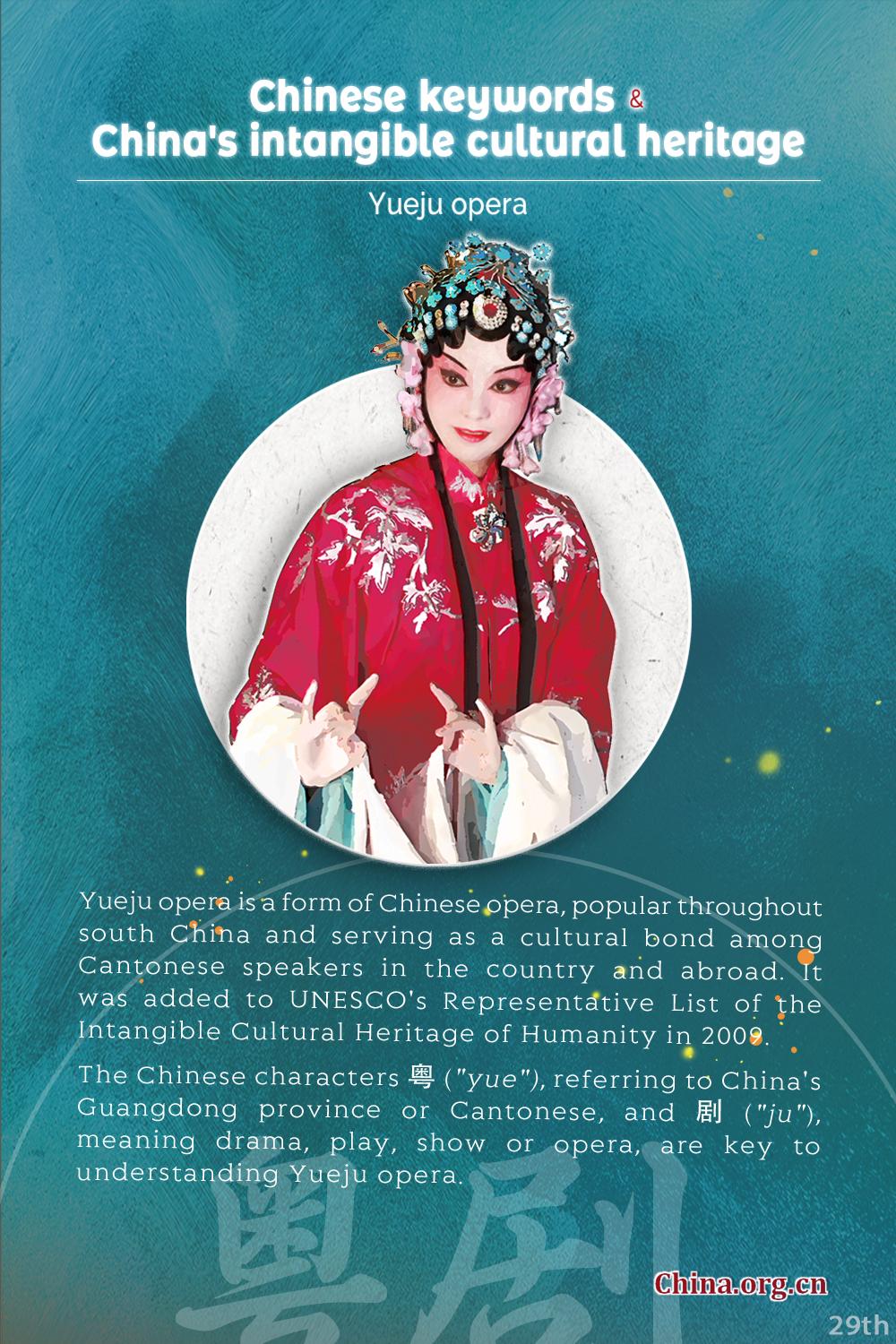
 0 Comment(s)
0 Comment(s) Print
Print E-mail China.org.cn, November 30, 2023
E-mail China.org.cn, November 30, 2023Editor's note: Yueju opera, or Cantonese opera, is a form of Chinese opera. It combines Mandarin operatic traditions with Cantonese dialect, and incorporates and develops singing and acting techniques of local operas in Cantonese-speaking regions, such as Guangdong province, Guangxi Zhuang Autonomous Region, Hong Kong and Macao.

Yueju opera is a cultural symbol for Cantonese speakers in China and abroad. In Southeast Asia, America, Oceania, Europe and Africa, it can often be heard in places where Cantonese-speaking overseas Chinese congregate. They are proud of its global popularity and influence, and see it as an important means to introduce their culture to foreign audiences.
The opera was added to UNESCO's Representative List of the Intangible Cultural Heritage of Humanity in 2009. The Chinese characters 粤 ("yue"), referring to China's Guangdong province or Cantonese, and 剧 ("ju"), meaning drama, play, show or opera, are key to understanding Yueju opera.
Yueju opera is well received for both its singing and fighting performances, as well as the accompaniment of string and percussion instruments, such as erxian (two-string fiddles), drum and gong, which are typical in local music of south China. The lead role of the opera is named "wenwusheng," who is good at both singing and fighting. Wenwusheng performers generally use real weapons and adopt Shaolin martial arts to present stunts and fights.
With a history of around 300 years, this opera has developed more than 10,000 repertories, telling historical epics, legendary tales and stories of folk life. It has also adopted elements of ceremonial, religious and sacrificial activities in some rural communities, and enriched itself with Cantonese embroidery, sculpture, ceramics and other local arts.
Since 2003, the local governments of Guangdong, Hong Kong and Macao have designated the last Sunday of each November as "Yueju Opera Day" to celebrate and preserve the rich heritage of this traditional art in the fast-evolving modern culture. In 2006, it was added to the first list of national-level intangible cultural heritage of China.
Large-scale surveys have been organized since 2015, contributing to the protection of important video and audio materials of more than 100 Yueju opera performances, and the conservation of nearly 500 classic opera scripts and a number of delicately designed costumes and headwear. Meanwhile, a multimedia databank has been established to digitize photos, videos and scripts. Teaching materials and books on Yueju opera's history and development have also been published.
Several higher education institutions in Guangdong, Hong Kong and Macao have established special organizations for the research, protection and inheritance of Yueju opera. Arts and drama schools have also put greater efforts into professional opera compositions, singing and acting studies, as well as training performers.
In 2021, the first Yueju opera film, "White Snake," was screened in China, bringing to life a beautiful love story between a white snake spirit and a human. The well-known legend was recreated this time by blending traditional Yueju opera with modern filmmaking, leaving audiences wowed by the traditional Chinese culture.
On Oct. 24, an art exhibition on precious Yueju opera-related collections opened at the Cantonese Opera Art Museum in Guangzhou, Guangdong province. A total of 200 exhibits collected in recent years were displayed, presenting both traditional and innovative aspects of the development of Yueju opera.
At its place of birth, Foshan city in Guangdong province, Yueju opera practitioners are actively involved in the artform's sustainable development. On Nov. 3, a new site for the Foshan Cantonese Opera Theater was unveiled, covering an area of 35,000 square meters and serving as Guangdong's largest and most comprehensive theater specializing in Cantonese opera performance. Here, new generations of audiences can enjoy both traditional performances as well as modern Yueju opera-related exhibitions and interactive activities supported by new technologies.
Discover more about China's intangible cultural heritage and their keywords:
• Item inscribed on UNESCO ICH list in 2022: Traditional tea processing
• Items in 2020: Wangchuan ceremony, Taijiquan
• Item in 2018: Lum medicinal bathing of Sowa Rigpa
• Item in 2016: Twenty-Four Solar Terms
• Item in 2013: Abacus-based Zhusuan
• Item in 2012: Training plan for Fujian puppetry performers
• Items in 2011: Shadow puppetry, Yimakan storytelling
• Items in 2010: Peking opera, acupuncture and moxibustion, wooden movable-type printing, watertight-bulkhead technology of Chinese junks, Meshrep
• Item in 2009: Yueju opera

Go to Forum >>0 Comment(s)